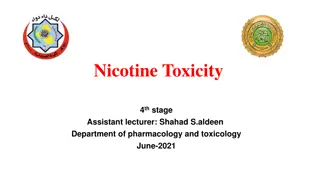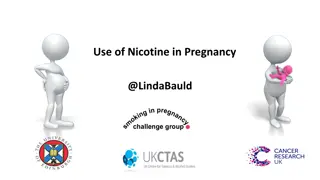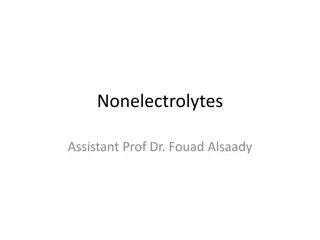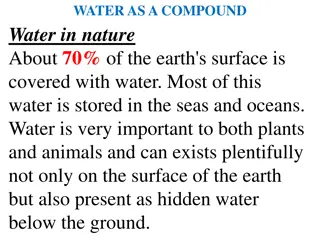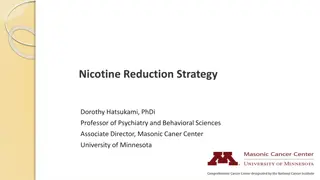Important Facts About Nicotine: Usage, Properties, and Sources
Nicotine is a stimulant and parasympathomimetic alkaloid naturally produced in nightshade family plants. It is used in smoking cessation. Nicotine is a hygroscopic liquid, soluble in various substances, and undergoes conversion processes under specific conditions. It has two enantiomeric forms and is found in tobacco plants and other Solanaceae family members. The biosynthetic pathway of nicotine involves coupling reactions between cyclic structures derived from niacin and N-methyl-1-pyrrolidium cation.
Download Presentation

Please find below an Image/Link to download the presentation.
The content on the website is provided AS IS for your information and personal use only. It may not be sold, licensed, or shared on other websites without obtaining consent from the author.If you encounter any issues during the download, it is possible that the publisher has removed the file from their server.
You are allowed to download the files provided on this website for personal or commercial use, subject to the condition that they are used lawfully. All files are the property of their respective owners.
The content on the website is provided AS IS for your information and personal use only. It may not be sold, licensed, or shared on other websites without obtaining consent from the author.
E N D
Presentation Transcript
Nicotine isa stimulant and potent parasympathomimetic alkaloid that is naturally produced in the nightshade family of plants. It is used for smoking cessation to relieve withdrawal symptoms. Nicotine acts as a receptor agonist at most nicotinic acetylcholine receptors (nAChRs), except at two nicotinic receptor subunits (nAChR 9 and nAChR 10) where it acts as a receptor antagonist.
Nicotine is a hygroscopic, colorless to yellow- brown, oily liquid, that is readily soluble in alcohol, ether or light petroleum. It is miscible with water in its neutral amine base form between 60 C and 210 C. It is a dibasic nitrogenous base, having Kb1=1 10 , Kb2=1 10 . It readily forms ammonium salts with acids that are usually solid and water-soluble. Its flash point is 95 C and its auto-ignition temperature is 244 C.Nicotine is readily volatile (vapor pressure 5.5 at 25 )On exposure to ultraviolet light or various oxidizing agents, nicotine is converted to nicotine oxide, nicotinic acid (niacin, vitamin B3), and methylamine.
Nicotine is optically active, having two enantiomeric forms. The naturally occurring form of nicotine is levorotatory with a specific rotation of [ ]D= 166.4 (( )-nicotine). The dextrorotatory form, (+)-nicotine is physiologically less active than ( )-nicotine. ( )- nicotine is more toxic than (+)-nicotine. The salts of (+)-nicotine are usually dextrorotatory; this conversion between levorotatory and dextrorotatory upon protonation is common among alkaloids. The hydrochloride and sulfate salts become optically inactive if heated in a closed vessel above 180 C. Anabasine is a structural isomer of nicotine, as both compounds have the molecular formula C10H14N2.
Nicotine is a natural product of tobacco, occurring in the leaves of Nicotiana tabacum in a range of 0.5 to 7.5% depending on variety. Nicotine is also found in the leaves of Nicotiana rustica, in amounts of 2 14%; in Duboisia hopwoodii; and in Asclepias syriaca.
Nicotine also naturally occurs in smaller amounts (varying from 2 7 g/kg, or 20 70 millionths of a percent wet weight) in Solanaceaein plants from the family Solanaceae (such as potatoes, tomatoes, eggplant, and peppers)
The biosynthetic pathway of nicotine involves a coupling reaction between the two cyclic structures that comprise nicotine. Metabolic studies show that the pyridine ring of nicotine is derived from niacin (nicotinic acid) while the pyrrolidine is derived from N-methyl- 1-pyrrollidium cation. Biosynthesis of the two component structures proceeds via two independent syntheses, the NAD pathway for niacin and the tropane pathway for N-methyl- 1-pyrrollidium cation.
Nicotine can be quantified in blood, plasma, or urine to confirm a diagnosis of poisoning or to facilitate a medicolegal death investigation. Urinary or salivary cotinine concentrations are frequently measured for the purposes of pre-employment and health insurance medical screening programs. Careful interpretation of results is important, since passive exposure to cigarette smoke can result in significant accumulation of nicotine, followed by the appearance of its metabolites in various body fluids. Nicotine use is not regulated in competitive sports programs.
The primary therapeutic use of nicotine is treating nicotine dependence to eliminate smoking and the damage it does to health. Controlled levels of nicotine are given to patients through gums, dermal patches, lozenges, inhalers, electronic/substitute cigarettes or nasal sprays to wean them off their dependence. A 2018 Cochrane Collaboration review found high quality evidence that all current forms of nicotine replacement therapy (gum, patch, lozenges, inhaler, and nasal spray) therapies increase the chances of successfully quitting smoking by 50 60%, regardless of setting.
Combining nicotine patch use with a faster acting nicotine replacement, like gum or spray, improves the odds of treatment success.4 mg versus 2 mg nicotine gum also increase the chances of success. In contrast to recreational nicotine products, which have been designed to maximize the likelihood of addiction, nicotine replacement products (NRTs) are designed to minimize addictiveness. The more quickly a dose of nicotine is delivered and absorbed, the higher the addiction risk.
Nicotine has been used as an insecticide since at least the 1690s, in the form of tobacco extracts (although other components of tobacco also seem to have pesticide effects).Nicotine pesticides have not been commercially available in the US since 2014, and homemade pesticides are banned on organic cropsand not recommended for small gardeners. Nicotine pesticides have been banned in the EU since 2009.
Foods are imported from countries in which nicotine pesticides are allowed, such as China, but foods may not exceed maximum nicotine levels. Neonicotinoids, which are derived from and structurally similar to nicotine, are widely used as agricultural and veterinary pesticides as of 2016. In nicotine-producing plants, nicotine functions as an antiherbivory chemical; consequently, nicotine has been widely used as an insecticide and neonicotinoids, such as imidacloprid, are widely used.
Nicotine-containing products are sometimes used for the performance-enhancing effects of nicotine on cognition.A meta-analysis of 41 double- blind, placebo-controlled studies concluded that nicotine or smoking had significant positive effects on aspects of fine motor abilities, alerting and orienting attention, and episodic and working memory.
A 2015 review noted that stimulation of the 42 nicotinic receptor is responsible for certain improvements in attentional performance; among the nicotinic receptor subtypes, nicotine has the highest binding affinity at the 4 2 receptor (ki=1 nM), which is also the biological target that mediates nicotine's addictive properties. Nicotine has potential beneficial effects, but it also has paradoxical effects, which may be due to the inverted U-shape of the dose-response curve or pharmacokinetic features.
Nicotine is used as a recreational drug.It is widely used because it is highly addictive and hard to discontinue using it.Nicotine is often used compulsively, and dependence can develop within days.Recreational drug users commonly use nicotine for its mood-altering effects.Other recreational nicotine products include chewing tobacco, cigars, cigarettes, e-cigarettes, snuff,pipe tobacco, and snus.






